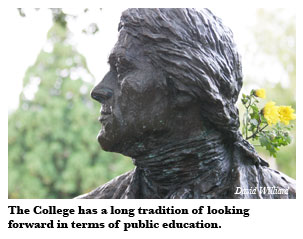Restructuring: A quiet revolution
 At midnight on July 1, 2006, a quiet
revolution took place at the College of William and Mary. While many of
us slept and dreamed of the upcoming Independence Day celebrations, the
College and its sister institutions throughout the Commonwealth began
to enjoy the benefits—as well as to encounter the obligations—of the
Higher Education Restructuring Act. Gov. Tim Kaine had signed the bill
in June, and the act came into force with the beginning of the new
fiscal year.
At midnight on July 1, 2006, a quiet
revolution took place at the College of William and Mary. While many of
us slept and dreamed of the upcoming Independence Day celebrations, the
College and its sister institutions throughout the Commonwealth began
to enjoy the benefits—as well as to encounter the obligations—of the
Higher Education Restructuring Act. Gov. Tim Kaine had signed the bill
in June, and the act came into force with the beginning of the new
fiscal year.
The conclusion of a three-year effort to secure operating flexibility and additional powers of self-governance, the act was principally the product of the effort of the College, Virginia Tech and the University of Virginia. However, it benefits all other public institutions in the state, and eventually it may serve as a paradigm for the reform of higher education throughout the nation.
“The act grants us the ability to use our own funds in the most efficient way, supervise the planning and construction of our own buildings, reward our employees in appropriate ways and manage all day-to-day functions so that we can finally develop a meaningful institutional plan that is more insulated from the ups and downs of the state budget,” said Gene R. Nichol, president of the College. “We must be good stewards of the trust the people of Virginia have granted us, and more importantly, we must all work together to ensure that we meet our obligations as an institution that is both great and public.”
Human-resource provisions
Although everyone on campus is affected by the act, many of William and Mary’s faculty, staff and students are probably not aware of its existence. One of the primary reasons for this is that few of the personnel policies that affect faculty and staff have changed.
 Under
the act, all employees hired prior to June 30, 2006, remain employees
of the state, retain the right to continue to participate in the
Virginia Retirement System and remain participants in state health
insurance programs. Employees who were hired into salaried non-faculty
positions as of July 1, 2006, are designated university employees, and
they are initially covered by the policies in place for state
employees. The Office of Human Resources is developing new policies and
procedures for these employees, who will be invited to participate in
discussions about the new system before it is implemented. Current
classified employees will be given the option to become university
employees as soon as the new system is in place.
Under
the act, all employees hired prior to June 30, 2006, remain employees
of the state, retain the right to continue to participate in the
Virginia Retirement System and remain participants in state health
insurance programs. Employees who were hired into salaried non-faculty
positions as of July 1, 2006, are designated university employees, and
they are initially covered by the policies in place for state
employees. The Office of Human Resources is developing new policies and
procedures for these employees, who will be invited to participate in
discussions about the new system before it is implemented. Current
classified employees will be given the option to become university
employees as soon as the new system is in place.
In addition, the College is still bound by the regulations of the state’s grievance policy for classified staff, and retirees who are 65 years of age or older can participate in the state’s Medicare Supplement Plan. The Retiree Health Care Credit will continue.
“We believe that in the future, we will be able to develop options for all employees that may be more attractive than the ones offered by the state,” said Anna Martin, vice president for administration. “Those hired before the start of this fiscal year will have the opportunity to choose which plan they wanted.”
Financial and accounting benefits
“Beginning in fiscal year 2007-2008—if we meet certain standards—the College will be able to invest locally generated funds for the benefit of our students, faculty and staff. Previously, the funds we collected through tuition and fees, auxiliary enterprises and other non-taxpayer fund mechanisms were deposited in Richmond, and the interest was retained by the state,” said Sam Jones, vice president for finance. “Students will be assured that all their tuition funds, including the interest, will be used to improve the programs that benefit them.”
In addition to giving College administrators greater control over locally generated funds, the restructuring act grants the Board of Visitors full authority to set tuition, fees and room and board charges, it gives the College the ability to issue bonds without prior approval of the state and it enables William and Mary to develop its own financial and accounting procedures.
Capital-outlay benefits
Enhanced flexibility is the major benefit the restructuring act brings to the College’s capital outlay procedures. Increased flexibility often equates to saved time and, eventually, to lower project costs. Under new procedures stipulated by the act, William and Mary can initiate non-general-fund projects without state approval, it can review locally certain design and construction elements, it can appoint a university building official who can inspect and certify completed projects for occupancy, it can conduct competitive negotiations without a maximum dollar limit and it can acquire and dispose of property bought with non-general funds without state approval.
“The most meaningful of these are the locally managed regulations on design and construction. U. Va. has estimated that these provisions can save as much as 25 percent in the time required to bring a building on line,” said Martin. She said that Bob Dillman has been appointed William and Mary Building Official, and he now is acting in that capacity on all construction projects.
Procurement and information technology
There were few changes to purchasing procedures under the act. Universities remain governed by regulations that are quite similar to those in place for state agencies. While some dollar thresholds have been moved upward to enhance flexibility, the College will continue to use eVA, the state’s electronic procurement system.
The College is now exempt from the regulations of the Virginia Information Technologies Agency (VITA). This change will enable William and Mary to support more effectively the technology needs of students, faculty and staff.
‘State asks’ and state responsibilities
Those who have followed the course of the restructuring legislation remember that the final bill included a set of ‘state asks,’ or requirements that colleges and universities must meet to secure administrative flexibility from the state.
“These ‘state asks’ included standards for accessibility, enrollment, educational effectiveness and other categories,” said Geoffrey Feiss, provost at the College. “Over the summer we began to negotiate specific targets for these standards with the State Council for Higher Education in Virginia (SCHEV), and we believe that we have reached agreement on a set of targets that will challenge us to improve, while recognizing that William and Mary is already one of the nation’s most effective and efficient educational institutions.”
Feiss said that soon SCHEV will present a set of targets developed specifically for each public college and university in the state. The targets will be considered by the SCHEV board and then implemented. Institutions will have six years to meet the targets that have been established.
“In addition to providing data about the College’s progress toward these goals, we also want to gather information about the successes we’ve had throughout the implementation period,” said Feiss. “I welcome information from anyone about how the provisions of restructuring have enabled us to serve our students or citizens of Virginia better. We are particularly interested in knowing how the provisions of the act have helped us save money or enabled us to use it more effectively”
Obligations and expectations
“In reconfirming our obligations to the state as embodied in the performance standards, we are demonstrating that restructuring is not a pathway toward independence, as some had feared, but the way to a reinvigorated partnership with the Commonwealth. To make this a reality, the state must continue to enhance its financial support for the College as it has over the past year,” said Stewart Gamage, the College’s vice president for public affairs.
In making the case for restructuring, William and Mary, U. Va and Virginia Tech showed that there was a multi-million-dollar gap between what the universities needed to operate their basic programs and what they were currently receiving. Restructuring will enable the institutions to maximize their resources, but the state has to supply the remainder in order for tuition increases to remain predictable.
“The General Assembly made a good down payment toward eliminating this gap during the session completed in the spring, and we will be pressing our case for additional support when we rev up the next ‘Road to Richmond’ campaign this fall and winter,” said Gamage.
She added that funding priorities identified by administrators at the College will continue to include increased support for faculty and staff salaries, student financial assistance.
 Skip to main content
Skip to main content
